![]()
![]()
![]()
Use LEFT and RIGHT arrow keys to navigate between flashcards;
Use UP and DOWN arrow keys to flip the card;
H to show hint;
A reads text to speech;
161 Cards in this Set
- Front
- Back
- 3rd side (hint)
|
3 types of asexual reproduction
|
Regeneration<br /><br />Budding<br /><br />Parthenogenesis
|
|
|
|
Dioecious
|
Organisms in which the two sexes are "housed" in two different individuals, so that eggs and sperm are not produced in the same individuals. Examples: humans, fruit flies, date palms
|
|
|
|
Monoecious
|
Organisms in which both sexes are "housed" in a single individual that produces both eggs and sperm. (In some plants, these are found in different flowers within the same plant.) Examples: corn, peas, earthworms, hydras
|
|
|
|
Oviparity
|
eggs hatch outwith mother
|
|
|
|
Viviparity
|
Reproduction in which fertilization of the egg and development of the embryo occur inside the mother's body
|
|
|
|
Parthenogenesis
|
The production of an organism from an unfertilized egg
|
|
|
|
Budding
|
Asexual reproduction in which a more or less complete new organism simply grows from the body of the parent organism and eventually detaches itself
|
|
|
|
Divergence of pentadactyl limb
|

|
|
|
|
An organism's ability to alter or "mold" itself in response to local environmental conditions
|
Plasticity
|
|
|
|
The evolutionary process whereby a population becomes better suited to its habitat
|
Adaptation
|
|
|
|
The process of an organism adjusting to change in its environment.
|
Acclimatisation
|
|
|
|
A major regional or global biotic community, such as a grassland or desert, characterized chiefly by the dominant forms of plant life and the prevailing climate.
|
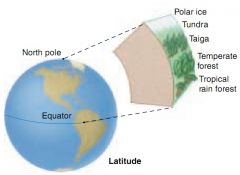
Biomes
|
|
|
|
The range of a environmental variable (temperature, pH, etc) at which an organism can survive
|
Zone of tolerance
|
|
|
|
An organism which can withstand a narrow temperature range
|
Stenotherm
|
|
|
|
An organism which can tolerate a wide range of temperature (e.g. camels)
|
Eurytherm
|
|
|
|
an organism that produces complex organic compounds from simple inorganic molecules using energy from light (by photosynthesis) or inorganic chemical reactions.
|
Autotroph
|
|
|
|
an organism that uses organic carbon for growth.
All animals, fungi, and many bacteria. |
Heterotroph
|
|
|
|
Definition
1 : Attached directly by the base : not raised upon a stalk or peduncle 2 : Permanently attached or established : not free to move about |
Sessile
|
|
|
|
An organism that is capable of living exclusively on inorganic materials, water, and some energy source such as sunlight or chemically reduced matter
|
Autotroph
|
|
|
|
An organism that requires preformed organic molecules as food
|
Heterotroph
|
|
|
|
Metabolic activity by which inorganic nitrogen-containing ions are reduced to form nitrogen gas and other products; carried on by certain soil bacteria
|
Denitrification
|
|
|
|
A mineral element required by plant tissues in concentrations of at least 1 milligram per gram of their dry matter
|
Macronutrient
|
|
|
|
A mineral element required by plant tissues in concentrations of less than 100 micrograms per gram of their dry matter
|
Micronutrient
|
|
|
|
The process by which nitrate (NO3-) is reduced to ammonia (NH3)
|
Nitrate reduction
|
|
|
|
The oxidation of ammonia to nitrite and nitrate ions, performed by certain soil bacteria
|
Nitrification
|
|
|
|
Conversion of nitrogen gas to ammonia, which makes nitrogen available to living things. Carried out by certain prokaryotes, some of them free-living and others living within plant roots
|
Nitrogen fixation
|
|
|
|
In nitrogen-fixing organisms, an enzyme complex that mediates the stepwise reduction of atmospheric N2 to ammonia
|
Nitrogenase
|
|
|
|
Organisms which acquire their energy from a solar source
|
Phototrophs
|
|
|
|
Organisms which acquire their energy from an organic source (food)
|
Chemotrophs
|
|
|
|
A condition in which leaves produce insufficient chlorophyll typically caused when leaves don't have enough nutrients to synthesise all the chlorophyll they need
|
Chlorosis
|
|
|
|
3 elements commonly used in fertilizers
|
N : Nitrogen
P : Phosphorus K : Potassium |
|
|
|
Simple leaf
|
(pic)
|
|
|
|
compound leaf
|
(pic)
|
|
|
|
Photosynthetic tissue in the interior of a leaf
|
Mesophyll
|
|
|
|
A noncellular, waxy covering over the epidermis of the aerial parts of plants that reduces water loss
|
Cuticle
|
|
|
|
An outer layer of cells that covers the body of plants and functions primarily for protection
|
Epidermis
|
|
|
|
One of a pair of epidermal cells that adjust their shape to form a stomatal pore for gas exchange.
|
Guard cell
|
|
|
|
Areas of localized cell division on the side of a plant that give rise to secondary tissues; causing an increase in the girth of the plant body.
|
Lateral meristems
|
|
|
|
An area of dividing tissue, located at the tip of a shoot or root, that gives rise to primary tissues; causing an increase in the length of the plant body
|
Apical meristems
|
|
|
|
3 plant tissue systems
|
–dermal
–vascular –ground |
|
|
|
The vascular tissue that conducts water and dissolved minerals in plants.
|
Xylem
|
|
|
|
The vascular tissue that conducts dissolved sugar and other organic compounds in plants.
|
Phloem
|
|
|
|
Plants need water for:
|
–photosynthesis
–transporting solutes –temperature control –support |
|
|
|
The mechanism by which dissolved sugar is thought to be transported in phloem; caused by a pressure gradient between the source (where sugar is loaded into the phloem) and the sink (where sugar is removed from phloem).
|
pressure-flow hypothesis
|
|
|
|
pressure-flow model
|
The mechanism by which dissolved sugar is thought to be transported in phloem; caused by a pressure gradient between the source (where sugar is loaded into the phloem) and the sink (where sugar is removed from phloem).
|
|
|
|
The loss of water vapor from the aerial surfaces of a plant (i.e., leaves and stems).
|
transpiration
|
|
|
|
The mechanism by which water and dissolved inorganic minerals are thought to be transported in xylem; water is pulled upward under tension due to transpiration while maintaining an unbroken column in xylem due to cohesion; also called transpiration-cohesion model.
|
Transpiration–tension-cohesion model
|
|
|
|
Transpiration–tension-cohesion model
|
The mechanism by which water and dissolved inorganic minerals are thought to be transported in xylem; water is pulled upward under tension due to transpiration while maintaining an unbroken column in xylem due to cohesion; also called transpiration-cohesion model.
|
|
|
|
Small pores located in the epidermis of plants that provide for gas exchange for photosynthesis; flanked by two guard cells, which are responsible for its opening and closing.
|
Stomata
|
|
|
|
Advantages of breathing air rather than water
|
~ 30 x O2 content
~ 8000 x diffusion rate less energy required to move air |
|
|
|
How does temperature affect O2 solubility
and haemoglobin O2 affinity? |
Increased temperature =
lowered O2 solubility lowered haemoglobin O2 affinity |
|
|
|
Openings on arthropods which lead to trachea. Can close to prevent water loss.
|
Spiracles
|
|
|
|
How does foetal haemoglobin differ from adult haemoglobin?
|
higher O2 affinity
|
|
|
|
oxygen-binding protein found in the muscle tissue of vertebrates in general and in almost all mammals
|
Myoglobin
–O2 reserve in muscle –bind 1 unit O2 –high O2 affinity |
|
|
|
Respiratory pigment used by Mollusca & Arthropoda
|
Haemocyanin
|
|
|
|
No. of heart chambers in fish
|
two
|
|
|
|
No. of heart chambers in amphibian & reptiles
|
three
|
|
|
|
No. of heart chambers in crocodilians and birds
|
four
|
|
|
|
Systole
|
Contraction of cardiac muscle
|
|
|
|
Diastole
|
Relaxation of cardiac muscle
|
|
|
|
Starling's law
|
Starling's law states that the greater the volume of blood entering the heart during diastole, the greater the volume of blood ejected during systolic contraction and vice-versa.
|
|
|
|
test
|
test
|
|
|
|
An organism which maintains its internal salinity such that it is always equal to the surrounding seawater.
|
Osmoconformer
e.g. Marine invertebrates |
|
|
|
An organism which tightly regulates it's body osmolarity
|
Osmoregulator
|
|
|
|
Osmolarity:
Isoosmotic Hypoosmotic Hyperosmotic |
Moles of solute per litre water
Isoosmotic –same osmolarity Hypoosmotic –lower osmolarity –Low solute concentration –more dilute Hyperosmotic –higher osmolarity –High solute concentration –less dilute |
|
|
|
Ammonotelic
Ureotelic Uricotelic |
Ammonotelic
Organisms which excrete ammonia Ureotelic Organisms which excrete urea Uricotelic Organisms which excrete uric acid |
|
|
|
Organisms which excrete ammonia
Organisms which excrete urea Organisms which excrete uric acid |
Organisms which excrete ammonia
Ammonotelic Organisms which excrete urea Ureotelic Organisms which excrete uric acid Uricotelic |
|
|
|
Excretory system of flatworms
|
Protonephridia
–conserve ions –excrete water |
|
|
|
Excretory system of insects
|
Malpighian tubules
–excrete semisolid wastes |
|
|
|
Excretory system of annelid worms
|
Metanephridia
–dilute urine with nitrogenous waste |
|
|
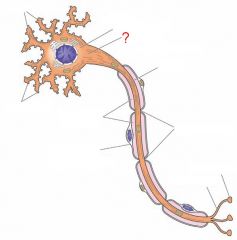
Anatomical part of a neuron that connects the cell body (the soma) to the axon
|

Axon Hillock
|
|
|
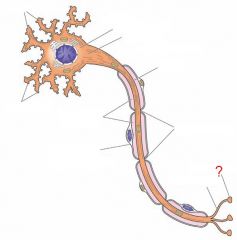
Specialized area within the axon of the presynaptic cell that contains neurotransmitters enclosed in synaptic vesicles
|

Bouton (foot)
|
|
|
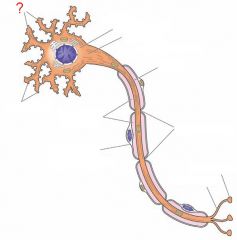
Branched projections of a neuron that act to conduct the electrochemical stimulation received from other neural cells
|

Dendrites
|
|
|
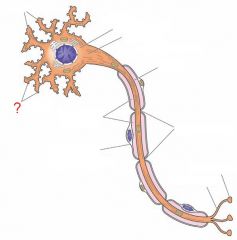
Small membranous protrusion from a neuron's dendrite that typically receives input from a single synapse
|

Dendritic spines
|
|
|
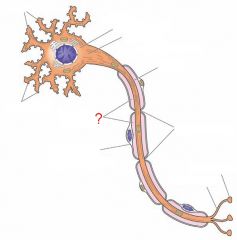
Electrically insulating material that forms a layer, around the axon of a neuron
|

Myelin sheath
|
|
|

Gaps formed between the myelin sheaths
|
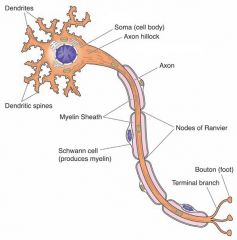
Nodes of Ranvier
|
|
|
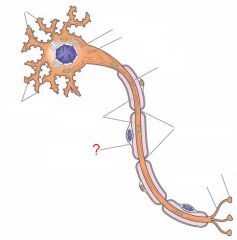
Glia of the peripheral nervous system that keep peripheral nerve fibres (both myelinated and unmyelinated) alive
|

Schwann Cells
|
|
|
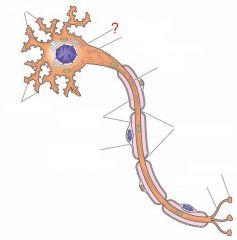
Bulbous end of a neuron containing the cell nucleus
|

Soma
|
|
|
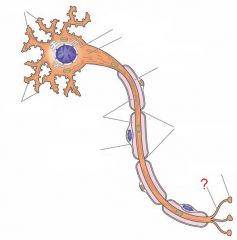
Distal terminations of the branches of an axon
|

Axon Terminal
|
|
|
|
Hormone released by the hypothalamus which stimulates secretion of gonadotrophins by the anterior pituitary
|
GnRH
Gonadotrophin releasing hormone |
|
|
|
Steroid hormone released by the A. pituitary which stimulates follicle development in the ovaries
|
FSH
Follicle stimulating hormone |
|
|
|
The two phases of the ovarian cycle
|
Follicular phase
Luteal phase |
|
|
|
Stages of a growing ovarian follicle
(1 - 5) |
1. Primordial follicle (immature)
2. Primary follicle (growing) 3. Antral follicle (+fluid filled space) 4. Graafian follicle 5. Corpus luteum (post ovulation) |
|
|
|
Process which triggers ovulation
|
Heightened oestrogen levels cause pituitary to switch to positive feedback causing a surge in LH hormones which trigger ovulation
|
|
|
|
Phases of the uterine cycle
|
Proliferative phase
Secretory phase |
|
|
|
Hormones secreted by corpus luteum
|
Progesterone
Oestrogen |
|
|
|
What triggers menstruation
|
Demise of corpus luteum - withdrawal of progesterone
|
|
|
|
What causes proliferation of the endometrium
|
Oestrogen from the ovary
|
|
|
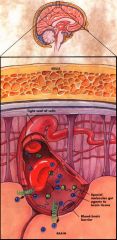
Blood brain barrier
|

Prevents free passage of certain
molecules to the brain |
|
|
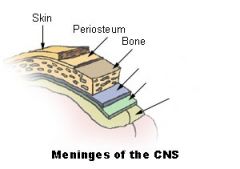
The 3 layers of the Meninges
|

1. Pia mater:nearest the brain, very delicate
2. Arachnoid mater: Thin and transparent, cushions the CNS 3. Dura mater: Next to the skull, tough. |
|
|
|
Cerebrospinal fluid
|
Present in subarachnoid space and ventricles.
Protects and nourishes the brain 80 - 150ml in adults |
|
|
|
Cerebrum:Basal ganglia
|
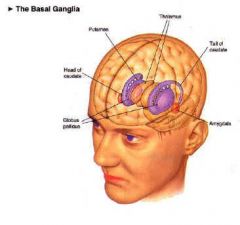
Several pairs of nuclei (where neurons from synapses with each other),
bi-laterally arranged. Input from cerebral cortex, hypothalamus and thalamus |
|
|
|
Cerebrum: Limbic system
|
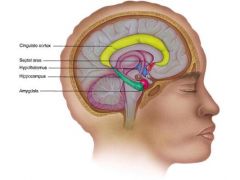
the seat of the emotional brain: pain, pleasure, docility, affection, anger and some aspects of memory
|
|
|
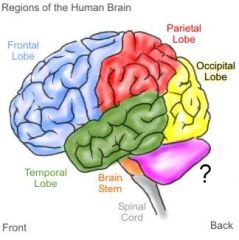
Name this part of the brain
|

The cerebellum
|
region of the brain that plays an important role in motor control. It is also involved in some cognitive functions such as attention and language, and probably in some emotional functions such as regulating fear and pleasure responses,[1] but its function in movement is the most clearly understood.
|
|
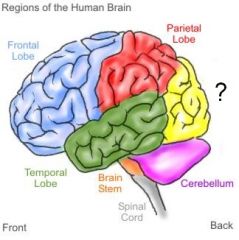
Name this part of the brain
|

The frontal lobe
|
The frontal lobe contains most of the dopamine-sensitive neurons in the cerebral cortex. The dopamine system is associated with reward, attention, long-term memory, planning, and drive.
|
|
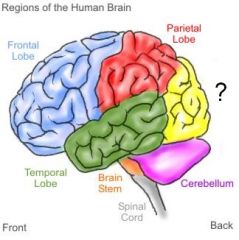
Name this part of the brain
|

The occipital lobe
|
the visual processing center of the mammalian brain containing most of the anatomical region of the visual cortex
|
|
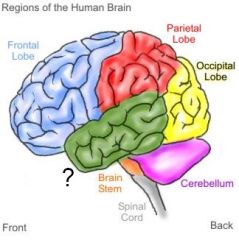
What part of the brain is this
|

The temporal lobe
|
The temporal lobe is involved in auditory processing and is home to the primary auditory cortex. It is also important for the processing of semantics in both speech and vision. The temporal lobe contains the hippocampus and plays a key role in the formation of long-term memory.
|
|
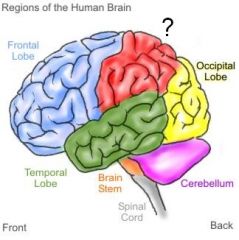
Name this part of the brain
|

The parietal lobe
|
The parietal lobe integrates sensory information from different modalities, particularly determining spatial sense and navigation. For example, it comprises somatosensory cortex and the dorsal stream of the visual system. This enables regions of the parietal cortex to map objects perceived visually into body coordinate positions.
|
|

Voluntary controlled division of the peripheral nervous system.
(Controls skeletal muscles) |

Somatic nervous system
|
|
|

Involuntary controlled division of the peripheral nervous system
(Regulates smooth muscle) |
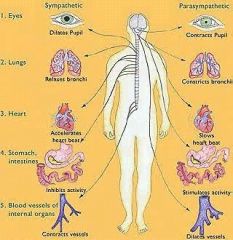
Autonomic nervous system
|
|
|

Name of nerves which carry impulses from the CNS to effector organs
|

Efferent
|
|
|
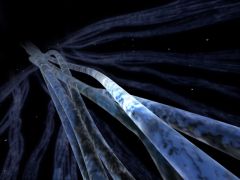
Name of nerves which carry impulses from sensors to the CNS
|

Afferent
|
|
|

Neurotransmitter(s) used by somatic efferent nerves
(Neuromuscular junction) |
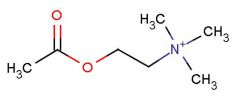
Acetylcholine (ACh)
|
|
|
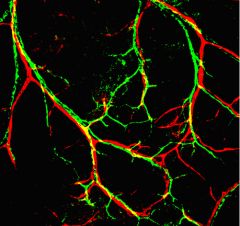
'Gut regulating' nervous system
|

Enteric nervous system
|
|
|
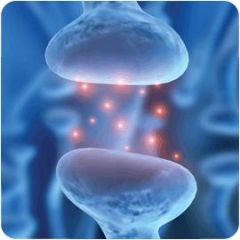
Neurotransmitter(s) used by the ANS
|

Acetylcholine (ACh)
Norepinephrine (NE) |
|
|
|
Term for a neuron which releases Acetylcholine
|
A cholinergic neuron
|
|
|
|
Term for a neuron which releases Norepinephrine
|
An Adrenergic neuron
|
|
|
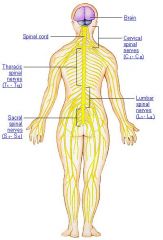
Location of sympathetic preganglionic neural cell bodies
|

12 thoracic segments and first two lumbar segments
|
|
|
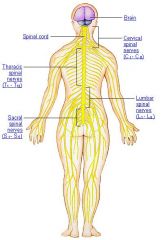
Location of parasympathetic preganglionic neuronal cell bodies
|

Spinal cord: Sarcal nerves and cranial nerves
|
|
|
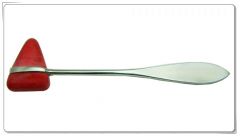
A very fast and predictable set of involuntary actions
|

A reflex
Somatic - uses skeletal muscles e.g. knee jerk Autonomic - effector is visceral e.g. digestion, defacation. |
|
|
|
A substance that is able to bind to and form a complex with a biomolecule to serve a biological purpose.
|
Ligand
|
|
|
|
a form of signaling in which a cell secretes a hormone or chemical messenger that binds to receptors on the same cell, leading to changes in the cell
|
Autocrine signalling
|
|
|
|
A form of cell signaling in which the target cell is near the signal-releasing cell
|
Paracrine signalling
|
|
|
|
Properties of steroid hormones
e.g. Testosterone |
Not water soluble
Lipophilic Diffuse across cell membrane and bind to cytosolic or nuclear receptors |
|
|
|
Properties of peptide hormones
e.g. Insulin |
Hydrorphilic
Lipophobic Binds to cell membrane receptors |
|
|
|
primary, secondary and tertiary endocrine disorders
|
Primary - endocrine gland dysfunctional
Secondary - the problem in the endocrine gland is secondary to a pituitary disorder Tertiary - the problem originates in the hypothalamus |
|
|
|
2 hormones secreted by the posterior pituitary (neurohypophysis)
|
ADH (vasopressin)
Oxytocin |
|
|
|
The system of blood vessels that link the hypothalamus and the anterior pituitary
|
Hypophyseal portal system
|
|
|
|
Anterior pituitary hormone which stimulates synthesis and secretion of thyroid hormones
|
TSH
thyroid-stimulating hormone |
|
|
|
Anterior pituitary hormones which stimulate steroid biosynthesis and
germ cell maturation in the gonads |
Gonadotrophins
LH and FSH |
|
|
|
Anterior pituitary hormone which stimulates steroid biosynthesis in adrenal cortex
|
ACTH
adrenocorticotrophic hormone |
|
|
|
Anterior pituitary hormone which stimulates growth
|
GH
Somatotrophin (growth hormone) |
|
|
|
Anterior pituitary hormone which stimulates lactation
|
Prolactin
|
|
|
|
The location of the thyroid gland
|
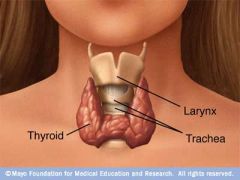
attached to the trachea just below the larynx
|
|
|
|
The ____ pump concentrates ____ from the diet in the thyroid gland
|
The IODIDE pump concentrates IODIDE from the diet in the thyroid gland
|
|
|
|
Synthesis of Thyroid hormones are regulated by:
|
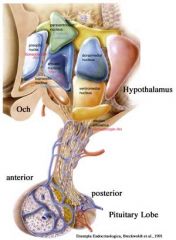
Thyroid stimulating hormone (TSH) released by the Anterior pituitary
|
|
|
|
TSH is regulated by:
|
TRH from the Hypothalamus
and Thyriod hormones |
|
|
|
Where do thyroid hormones bind?
|
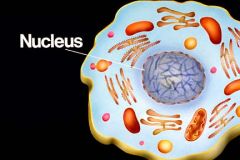
Nuclear thyroid receptors in target tissues
|
|
|
|
The general action of thyroid hormones
|
Increases basal metabolic rate
|
|
|
|
How are thyroid hormones regulated after being released?
|
Peripheral deiodinases
Convert T4 to T3 |
|
|
|
Thyroid hormones secreted from thyroid gland
|

(T4) Thyroxine
-4 times as much (T3) Triiodothyronine -more active |
|
|
|
Thyroid hormones are synthesised by:
|
The Iodination of thyroglobulin
|
|
|
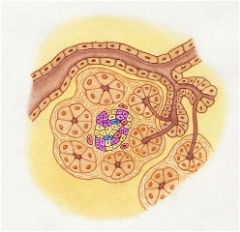
Cells in the pancreas which secrete glucagon
|

α cells
|
|
|
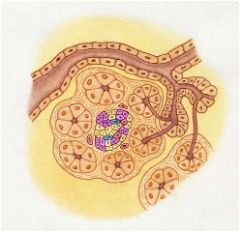
Cells in the pancreas which secrete somatostatin (growth hormone-inhibiting hormone (GHIH))
|

Delta cells (δ-cells or D cells)
|
|
|
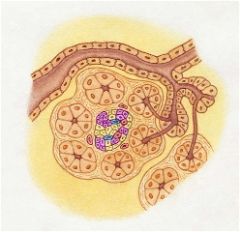
Cells in the pancreas which secrete pancreatic polypeptide
|

F cells
|
PP cells (F cells) are pancreatic polypeptide producing cells in the islets of Langerhans in the pancreas. They are very few in number and are polygonal in shape.
Using an electron microscope, PP-cells have been found to be up to 140 nm in diameter, have very few organelles and few granules. |
|
|
how does insulin affect gluconeogenesis?
|
Insulin INHIBITS gluconeogenesis
|
|
|
|
how does insulin affect lipogenesis?
|
Insulin STIMULATES lipogenesis
|
|
|
|
how does insulin affect protein synthesis?
|
Insulin STIMULATES protein synthesis
|
|
|
|
Lower than normal level of blood glucose
|
Hypoglycaemia
|
|
|
|
Higher than normal level of blood glucose
|
Hyperglycaemia
|
|
|
|
The pancreas' response to hypoglycaemia
|
Glucagon secretion
|
|
|
|
Cells which make up 70-80% of the liver's cytoplasmic mass
|
Hepatocytes
|
|
|
|
The pancreas' response to hyperglycaemia
|
Insulin secretion
|
|
|
|
Hormones secreted by adrenal medulla
|
Epinephrine
Nor epinephrine |
|
|
|
Hormones secreted by the adrenal cortex
|
Mineralocorticoids (e.g. Aldosterone)
Glucocorticoids (e.g. Cortisol) |
|
|
|
Role of mineralocorticoids
e.g. Aldosterone |
Increased blood volume / pressure by promoting Na+ and water resorption
|
|
|
|
Role of glucocorticoids
e.g. cortisol |
Catabolic - Increased blood glucose level
Reduced inflammation, swelling & pain |
|
|
|
Growth optimum between pH 0 and 5.5
Sulfolobus, Picrophilus, Ferroplasma, Acontium, Cyanidium caldarium |
Acidophile
Sulfolobus, Picrophilus, Ferroplasma, Acontium, Cyanidium caldarium |
|
|
|
Growth optimum between pH 5.5 and 8.0
Escherichia, Euglena, Paramecium |
Neutrophile
Escherichia, Euglena, Paramecium |
|
|
|
Growth optimum between pH 8.5 and 11.5
Bacillus alcalophilus, Natronobacterium |
Alkalophile
Bacillus alcalophilus, Natronobacterium |
|
|
|
Grows well at 0°C and has an optimum growth temperature of 15°C or lower
Bacillus psychrophilus, Chlamydomonas nivalis |
Psychrophile
Bacillus psychrophilus, Chlamydomonas nivalis |
|
|
|
Can grow at 0–7°C; has an optimum between 20 and 30°C and a maximum around 35°C
|
Psychrotroph
Listeria monocytogenes, Pseudomonas fluorescens |
|
|
|
Has growth optimum around 20–45°C
Escherichia coli, Neisseria gonorrhoeae, Trichomonas vaginalis |
Mesophile
Escherichia coli, Neisseria gonorrhoeae, Trichomonas vaginalis |
|
|
|
Can grow at 55°C or higher; optimum often between 55 and 65°C
Bacillus stearothermophilus, Thermus aquaticus, Cyanidium caldarium, Chaetomium thermophile |
Thermophile
Bacillus stearothermophilus, Thermus aquaticus, Cyanidium caldarium, Chaetomium thermophile |
|
|
|
Has an optimum between 80 and about 113°C
Sulfolobus, Pyrococcus, Pyrodictium |
Hyperthermophile
Sulfolobus, Pyrococcus, Pyrodictium |
|
|
|
Completely dependent on atmospheric O2 for growth.
Micrococcus luteus, Pseudomonas, Mycobacterium; most algae, fungi, and protozoa |
Obligate aerobe
Micrococcus luteus, Pseudomonas, Mycobacterium; most algae, fungi, and protozoa |
|
|
|
Does not require O2 for growth, but grows better in its presence.
Escherichia, Enterococcus, Saccharomyces cerevisiae |
Facultative anaerobe
Escherichia, Enterococcus, Saccharomyces cerevisiae |
|
|
|
Grows equally well in presence or absence of O2
Streptococcus pyogenes |
Aerotolerant anaerobe
Streptococcus pyogenes |
|
|
|
Does not tolerate O2 and dies in its presence.
Clostridium, Bacteroides, Methanobacterium, Trepomonas agilis |
Obligate anaerobe
Clostridium, Bacteroides, Methanobacterium, Trepomonas agilis |
|
|
|
Requires O2 levels below 2–10% for growth and is damaged by
atmospheric O2 (20%). Campylobacter, Spirillum volutans, Treponema pallidum |
Microaerophile
Campylobacter, Spirillum volutans, Treponema pallidum |
|
|
|
Growth more rapid at high hydrostatic pressures.
Photobacterium profundum, Shewanella benthica, Methanococcus jannaschii |
Barophilic
Photobacterium profundum, Shewanella benthica, Methanococcus jannaschii |
|

